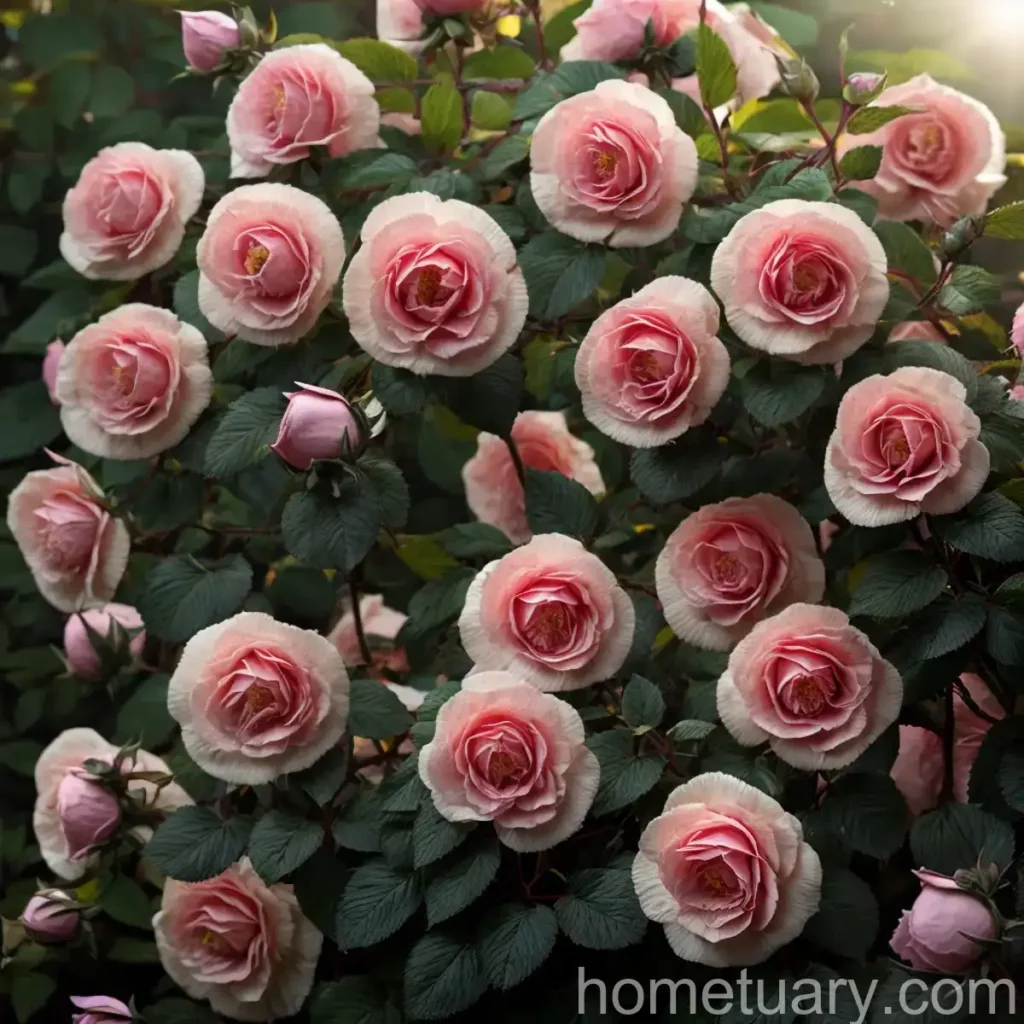Hybrid Rugosa Rose (Rosa ‘Hansa’)
The Rosa ‘Hansa,’ commonly known as the hybrid rugosa rose, is a particularly beautiful and hardy variety of rose. As a plant scientist, I am excited to share insights into the cultivation, care, and unique characteristics of this stunning flowering plant. In this comprehensive guide, we will dive into the culture, uses, care requirements, pruning, propagation, and much more about the hybrid rugosa rose. Whether you are an experienced gardener or just starting, this article will equip you with the knowledge needed to cultivate and appreciate this remarkable plant.
What is the Hybrid Rugosa Rose?
Rosa ‘Hansa’ is a member of the rugosa rose family, which is renowned for its resilience and striking appearance. This hybrid variety is particularly cherished for its deep pink to purple-red blooms and remarkable fragrance. The rugosa roses are known for their tolerance to harsh conditions, making them suitable for diverse climates and soil types. The ‘Hansa’ cultivar is specifically admired for its disease resistance and robust growth habits, making it a popular choice for landscapers and home gardeners alike.
Key Takeaways
Let’s start exploring the key takeaways of the hybrid rugosa rose. This section will provide a quick overview of what you can expect to learn about the culture, uses, care requirements, and distinctive features of this exquisite plant.
Culture
Rosa ‘Hansa’
- Hardy and resilient rugosa rose variety
- Adaptable to various soil types and climates
- Resistant to common rose diseases
- Striking deep pink to purple-red blooms
- Fragrant flowers
Uses
- Ornamental purposes in gardens and landscapes
- Wildlife attraction
- Flower arrangement and decorative purposes
- Fragrance gardens
Water
- Moderate water needs
- Tolerant of occasional drought
- Well-draining soil
Sunlight
- Thrives in full sun to partial shade
- Requires at least 6-8 hours of sunlight per day
Fertilizer
- Balanced fertilizer during spring
- Minimal fertilization requirements
Soil
- Tolerant of various soil types
- Well-draining, slightly acidic soil
Pruning
- Minimal pruning requirements
- Prune to shape and remove dead wood
- Pruning after flowering season
Propagation
- Propagate through softwood cuttings
- Grafting and budding methods
Container
- Suitable for container gardening
- Large containers for adequate root space
Popularity
- Widely admired for its hardiness and resilience
- Popular choice for landscape designs
- Preferred for its disease resistance
Common Diseases
- Resistance to common rose diseases
- Minimal susceptibility to fungal infections
- Hardy in various weather conditions
Disease Diagnosis
- Common rose diseases such as powdery mildew and black spot
- Regular inspection for signs of diseases
Common Pests
- Minimal pest susceptibility
- Potential for aphid and Japanese beetle infestations
- Natural pest control methods
Botanist’s Tips
- Understand the plant’s resilience and hardiness
- Appreciate the fragrance and striking blooms
- Complement with suitable companion plants
- Provide adequate sunlight and well-draining soil
Fun Facts
- The ‘Hansa’ rose is named after a powerful merchant guild in Northern Europe during the medieval period
- Rugosa rose hips are edible and rich in vitamin C
- The fragrance of the ‘Hansa’ rose enhances garden spaces and attracts pollinators
Links to External Resources
Now that we have covered the key takeaways, let’s delve deeper into each aspect of the hybrid rugosa rose, offering detailed insights into its cultivation, care, and other aspects.
Culture
The culture of the hybrid rugosa rose encompasses its unique characteristics, resilience, and requirements for optimal growth and flowering. Understanding the cultural aspects of this plant is essential for creating a suitable environment for its development.
Hybrid Rugosa Rose (Rosa ‘Hansa’)
Rosa ‘Hansa’ is a hardy and resilient shrub rose renowned for its adaptability and striking blooms. The culture of this hybrid rugosa rose emphasizes its tolerance to diverse conditions and its ability to thrive in various settings.
The following are some key cultural traits of the hybrid rugosa rose:
-
Hardiness: The ‘Hansa’ rose is appreciated for its robust growth and ability to withstand challenging weather conditions. It is suitable for cultivation in different climate zones, making it a versatile addition to garden landscapes.
-
Adaptability: This rugosa rose variety demonstrates a remarkable tolerance to various soil types, including sandy, loamy, and clay soils. Its ability to thrive in different soil conditions makes it an attractive choice for home gardens and public landscapes.
-
Disease Resistance: ‘Hansa’ is notably resistant to common rose diseases such as powdery mildew and black spot. This resistance reduces the need for frequent pesticide applications, making it an environmentally friendly option for gardeners.
-
Striking Blooms: The deep pink to purple-red blooms of the ‘Hansa’ rose exhibit a rich and vibrant color that adds a touch of elegance to garden spaces. The blossoms are not only visually appealing but also emit a delightful fragrance, enhancing the overall ambiance of the surroundings.
-
Fragrance: The fragrance of the ‘Hansa’ rose is one of its most captivating features. The sweet and distinctive scent of its blooms enriches garden spaces and attracts pollinators, contributing to a thriving ecosystem.
Rugosa Rose Varieties
The rugosa rose family encompasses a variety of cultivars, each with its own unique characteristics and appeal. Beyond the ‘Hansa’ rose, there are several other rugosa rose varieties that gardeners and enthusiasts may find intriguing. Some notable rugosa rose varieties include:
-
Rosa Rugosa: The species from which many rugosa hybrids derive, the Rosa rugosa, exhibits robust growth habits and notable resistance to common rose diseases.
-
Rosa Virginiana: This native species of Virginia is also part of the rugosa rose family and features beautiful pink blooms and a hardy nature.
-
Rosa Blanc Double de Coubert: Known for its stunning double white blooms, this rugosa rose variety is a popular choice for ornamental gardens and landscapes.
-
Rosa Alba: A historic variety with beautiful white or light pink blooms, the Rosa alba is appreciated for its classic charm and graceful appearance.
Embracing the diversity within the rugosa rose family allows gardeners to explore various options for incorporating these resilient and enchanting plants into their landscapes.
Hansa Rose Bush
The term “Hansa rose bush” refers to the Rosa ‘Hansa,’ a specific hybrid rugosa rose cultivar celebrated for its outstanding traits, including its striking blooms, disease resistance, and adaptability. When considering the Hansa rose bush, it is essential to recognize its distinct features and the care it requires to flourish.
The following are some noteworthy features of the Hansa rose bush:
-
Bloom Color: The Hansa rose bush produces deep pink to purple-red blooms, creating a visually stunning spectacle in garden settings. The vibrancy of its blossoms adds a touch of allure to outdoor spaces.
-
Disease Resistance: The Hansa rose bush exhibits remarkable resistance to common rose diseases, contributing to its low maintenance requirements and overall health and vitality.
-
Fragrance: The fragrance of the Hansa rose bush is a delightful fusion of sweet and captivating aromas, enhancing the sensory experience within gardens and landscapes.
-
Adaptability: This hardy rose bush is known for its adaptability to various growing conditions and soil types, making it an excellent choice for gardeners seeking a resilient and versatile plant.
Understanding the distinctive characteristics of the Hansa rose bush provides valuable insights into its potential uses and care requirements, allowing for informed decision-making when incorporating it into garden designs.
Rugosa Rose Care
Caring for rugosa roses, including the hybrid variety Rosa ‘Hansa,’ involves providing adequate growing conditions, maintenance, and occasional nurturing to ensure their optimal health and vibrant blooms. The care guidelines for rugosa roses are tailored to their hardy nature, disease resistance, and adaptability.
Key aspects of rugosa rose care include:
-
Water: Rugosa roses, including the ‘Hansa’ variety, require moderate watering and are tolerant of occasional drought. Providing well-draining soil helps maintain optimal moisture levels without leading to waterlogging, which can negatively impact the plants’ health.
-
Sunlight: Thriving in full sun to partial shade, rugosa roses benefit from at least 6-8 hours of sunlight per day. Adequate exposure to sunlight contributes to robust growth and abundant flowering.
-
Fertilizer: Minimal fertilization is necessary for rugosa roses, with balanced fertilizer applications during the spring months, supporting healthy growth and bloom production. Care should be taken to avoid excessive fertilization, which can lead to imbalanced growth and reduced disease resistance.
-
Soil: Tolerant of various soil types, rugosa roses prefer well-draining, slightly acidic soil. Amending the soil with organic matter, such as compost, can enhance its structure and fertility, promoting optimal growth conditions for the plants.
Cultivating and caring for rugosa roses involves maintaining a balanced approach to their needs, respecting their hardy nature, and leveraging their resilience to create remarkable garden displays.
Uses
The hybrid rugosa rose, Rosa ‘Hansa,’ offers a range of versatile uses within garden landscapes, decorative settings, and even culinary pursuits. Understanding the various uses of this enchanting plant provides insight into its potential roles and contributions within diverse environments.
Ornamental Purposes
Rosa ‘Hansa’ is primarily cherished for its ornamental value, adorning gardens, parks, and public spaces with its striking blooms and robust foliage. Its vibrant pink to purple-red flowers create captivating focal points within garden landscapes, adding visual allure and elegance to the surroundings.
Whether incorporated into traditional garden designs or modern landscaping concepts, the ‘Hansa’ rose serves as a versatile and charming ornamental plant, enriching outdoor spaces with its enduring beauty.
Wildlife Attraction
The fragrant blooms of the hybrid rugosa rose attract pollinators such as bees, butterflies, and hummingbirds, fostering a thriving ecosystem within garden environments. By providing a food source and habitat for beneficial insects and pollinators, the ‘Hansa’ rose contributes to the biodiversity and ecological balance of outdoor spaces.
Beyond its fragrance, the rugosa rose hips are also nourishing and attractive to wildlife, offering an additional dimension of value to the plant’s role in supporting local ecosystems.
Flower Arrangement and Decorative Purposes
The vibrant and fragrant blooms of the ‘Hansa’ rose make it a desirable choice for floral arrangements and decorative displays. Whether incorporated into indoor settings or showcased in outdoor gatherings, the roses serve as captivating focal points, infusing spaces with natural beauty and delightful aromas.
The versatility of the hybrid rugosa rose in various decorative applications underscores its appeal as a multi-purpose plant, providing visual, olfactory, and aesthetic benefits.
Fragrance Gardens
With its enchanting and captivating scent, the ‘Hansa’ rose is a fitting addition to fragrance gardens, where the emphasis is on cultivating plants with aromatic blooms and foliage. Its distinctive fragrance enhances the sensory experience within garden landscapes, inviting visitors to savor the delightful scents and revel in the inherent beauty of the plant.
By incorporating the ‘Hansa’ rose into fragrance gardens, enthusiasts and gardeners can create immersive and captivating outdoor havens enriched by the allure of natural aromas and floral elegance.
Water
The water requirements of the hybrid rugosa rose, Rosa ‘Hansa,’ align with its hardy nature and capacity to withstand varying moisture levels. Understanding the plant’s water needs is fundamental to providing adequate care and fostering optimal growth and flowering.
Watering Guidelines
Rugosa roses, including the ‘Hansa’ variety, generally require moderate watering, with a focus on maintaining consistent soil moisture without creating waterlogged conditions. These guidelines ensure that the plants receive sufficient hydration while avoiding excessive moisture, which can lead to root rot and other detrimental effects.
The following are essential considerations for watering the ‘Hansa’ rose:
-
Moderate Watering: Providing the ‘Hansa’ rose with moderate, consistent watering supports healthy growth and flowering. The goal is to ensure that the soil remains evenly moist without becoming overly saturated.
-
Tolerant of Occasional Drought: Rugosa roses exhibit a degree of tolerance to occasional drought, making them suitable for environments where water availability may fluctuate. However, consistent moisture is still preferable to promote optimal health and vigor.
-
Well-Draining Soil: Enabling the soil to drain effectively helps prevent waterlogging and minimizes the risk of root-related problems. Amending the soil with organic matter and ensuring proper drainage promotes balanced moisture levels for the ‘Hansa’ rose.
By adhering to appropriate watering practices and recognizing the plant’s resilience to varying moisture conditions, gardeners can provide the ‘Hansa’ rose with an environment conducive to flourishing and blooming abundantly.
Sunlight
The sunlight requirements of the hybrid rugosa rose, Rosa ‘Hansa,’ play a vital role in shaping its growth, flowering patterns, and overall health. By understanding the plant’s sunlight needs, gardeners can optimize its growing conditions, harness its resilience, and promote its ornamental value within garden landscapes.
Sunlight Preferences
Rugosa roses, including the ‘Hansa’ variety, thrive in full sun to partial shade, exhibiting a preference for direct sunlight exposure for a significant portion of the day. Adequate sunlight is essential for stimulating robust growth, abundant flowering, and the development of vibrant foliage.
Key considerations regarding sunlight for the ‘Hansa’ rose include:
-
Full Sun to Partial Shade: Providing the ‘Hansa’ rose with full sun to partial shade allows it to receive the necessary light levels for photosynthesis and energy production. At least 6-8 hours of direct sunlight per day is recommended to support optimal growth and blooming.
-
Sunlight Availability: Assessing the availability of sunlight within garden spaces helps identify suitable planting locations for the ‘Hansa’ rose. Areas with ample sunlight exposure are ideal for promoting its vigorous development and vibrant floral displays.
-
Sunlight and Flowering: Adequate sunlight exposure contributes to prolific flowering, fostering the production of vibrant pink to purple-red blooms that define the ornamental allure of the ‘Hansa’ rose. Ample sunlight encourages the plant to showcase its full potential and visual appeal.
By aligning the ‘Hansa’ rose with its sunlight preferences, gardeners can create an environment that harnesses the plant’s vitality and decorative charm, ensuring its flourishing presence within outdoor settings.
Fertilizer
Fertilizing the hybrid rugosa rose, Rosa ‘Hansa,’ involves providing balanced nutrients to support its growth, flowering, and overall vitality. Understanding the fertilizer requirements of the plant enables gardeners to enhance its health and ornamental value within garden landscapes.
Fertilization Guidelines
The following guidelines outline essential considerations for fertilizing the ‘Hansa’ rose:
-
Balanced Fertilizer: Applying a balanced fertilizer during the spring months supports the ‘Hansa’ rose’s nutritional needs, fostering robust growth, abundant blooms, and strong root development. A slow-release or organic fertilizer can provide sustained nourishment over an extended period, promoting optimal plant health.
-
Minimal Fertilization Requirements: Rugosa roses, including the ‘Hansa’ variety, generally exhibit minimal fertilization requirements, as excessive nutrient application can lead to imbalanced growth and reduced disease resistance. Following conservative fertilization practices ensures that the plant receives the necessary nutrients without overwhelming its system.
-
Nutrient Uptake: Providing the ‘Hansa’ rose with appropriate fertilizer promotes efficient nutrient uptake, allowing the plant to utilize the available resources for sustained growth, flowering, and vitality. Balancing the nutritional regime supports the plant’s overall well-being without compromising its resilience.
By adhering to suitable fertilization practices tailored to the ‘Hansa’ rose’s requirements, gardeners can nurture its enduring beauty and optimize its role within garden landscapes.
Soil
The soil preferences of the hybrid rugosa rose, Rosa ‘Hansa,’ influence its growth, root development, and overall health. Cultivating an environment with suitable soil conditions allows the plant to thrive, produce vibrant blooms, and contribute to the visual allure of garden landscapes.
Soil Preferences
Rugosa roses, including the ‘Hansa’ variety, exhibit preferences for well-draining, slightly acidic soil, characterized by the following attributes:
-
Well-Draining Soil: Ensuring that the soil effectively drains excess moisture promotes optimal root conditions and prevents waterlogging, which can harm the ‘Hansa’ rose’s health. Amending the soil to enhance its drainage capacity is beneficial for supporting the plant’s growth and vitality.
-
Slightly Acidic pH: Rugosa roses thrive in slightly acidic soil with a pH range of approximately 6.0 to 6.5. Providing the ‘Hansa’ rose with a suitable pH environment fosters efficient nutrient uptake and supports balanced growth and flowering.
-
Soil Composition: Cultivating the ‘Hansa’ rose in loamy or sandy soil rich in organic matter promotes favorable soil structure and fertility, creating an environment conducive to the plant’s resilience and ornamental value.
Optimizing the soil conditions for the ‘Hansa’ rose enables gardeners to create a nurturing environment that promotes its vigorous growth, vibrant blooms, and enduring presence within garden settings.
Pruning
Pruning the hybrid rugosa rose, Rosa ‘Hansa,’ involves attentive care and maintenance to shape the plant, remove dead wood, and stimulate healthy growth and flowering. Understanding the pruning requirements of the ‘Hansa’ rose allows gardeners to optimize its ornamental value and promote its long-term health and vitality.
Pruning Guidelines
The following guidelines highlight essential considerations for pruning the ‘Hansa’ rose:
-
Minimal Pruning Requirements: Rugosa roses generally exhibit minimal pruning requirements, emphasizing the plant’s natural growth habits and resilience. Pruning efforts focus on shaping the plant and removing dead or damaged wood, supporting its overall health and aesthetic appeal.
-
Pruning After Flowering: Pruning the ‘Hansa’ rose after its flowering season concludes allows for the removal of spent blooms and encourages new growth and potential reblooming. Trimming the plant at the appropriate time promotes its vigor and future flowering capacity.
-
Prune to Shape: Shaping the ‘Hansa’ rose through selective pruning enables gardeners to maintain its desired form and structure, creating an attractive and well-manicured appearance within garden landscapes.
By adopting suitable pruning practices aligned with the ‘Hansa’ rose’s growth patterns and maintenance needs, gardeners can nurture its enduring beauty and optimize its role as an ornamental focal point within outdoor settings.
Propagation
Propagating the hybrid rugosa rose, Rosa ‘Hansa,’ involves employing various techniques such as softwood cuttings, grafting, and budding methods to reproduce the plant and expand its presence within garden landscapes. Understanding the propagation methods for the ‘Hansa’ rose enables gardeners to propagate new plants and appreciate its ornamental value across diverse settings.
Propagation Methods
The following propagation methods offer gardeners versatile approaches to reproducing the ‘Hansa’ rose and cultivating new plants:
- Softwood Cuttings: Propagating the ‘Hansa’ rose through softwood cuttings involves taking tender, actively growing stems and encouraging their root development in a suitable growing medium. This method allows for the efficient replication















